- MySQL: Architecture And Features
- MySQL Interview Questions
Best MySQL Interview Questions With Answers For Revision
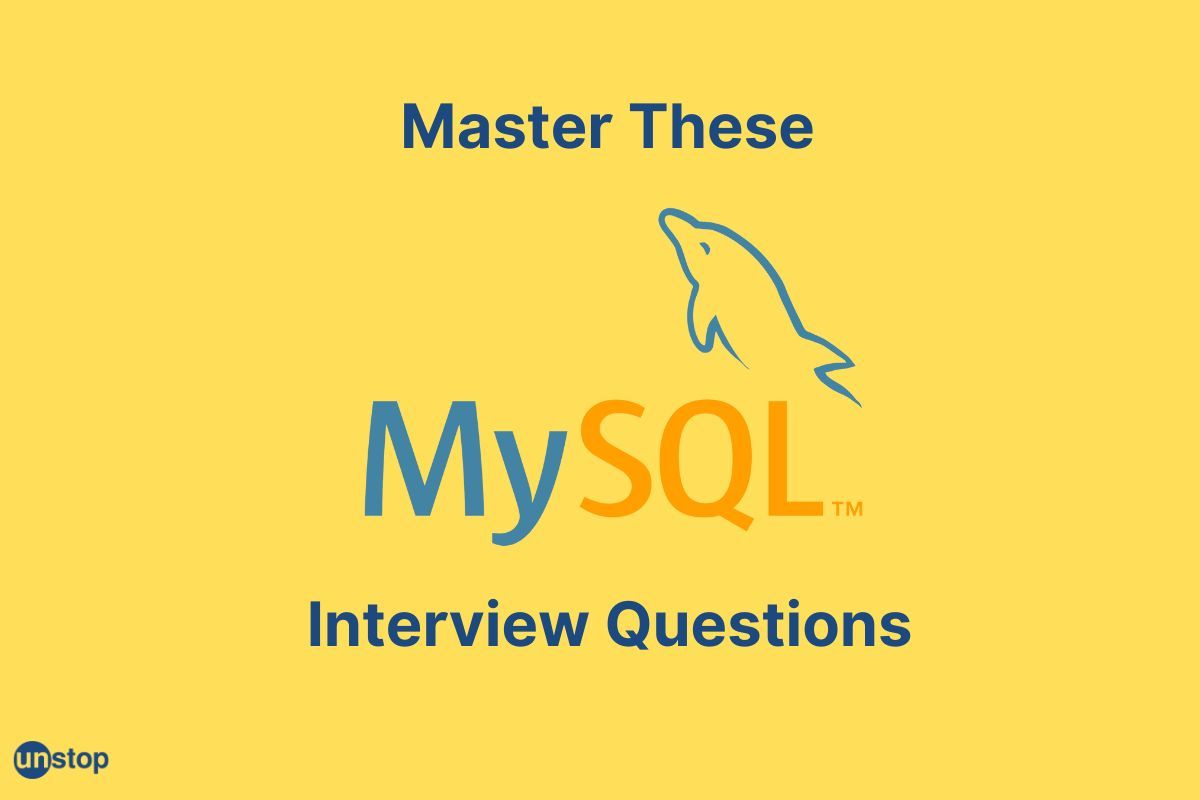
MySQL is an open-source, SQL-based relational database management system (RDBMS). For over two decades, MySQL has been employed by the tech community. The name MySQL is a combination of the co-founder's daughter's name and an acronym - 'My' is the name of co-founder Michael Widenius's daughter and SQL stands for Structured Query Language. Widenius co-founded MySQL with David Axmark.
Today, MySQL is widely used to store data in websites and applications because of its dependability, steadiness, and security features.
MySQL: Architecture And Features
There are two main components of its client-server architecture: the MySQL server and the client library. The server acts as a central repository. It stores, manages, and processes data. The client library is the software component in the client-server architecture of MySQL. It enables applications to communicate with the server through an interface. A client library can either be linked or embedded into different programs. For example, when setting up active sites for critical implementations along with incorporating databases into software systems and home appliances.
MySQL offers a range of features that allow for optimized performance, database recovery & replication to ensure data redundancy. It also enables easy integration into existing networks or infrastructures using standard protocols like TCP/IP. The powerful query optimizer of MySQL can process various intricate queries quickly and efficiently while also providing users with access levels that grant certain privileges over data stored within its databases.
Find below a list of important MySQL interview questions, along with answers.

MySQL Interview Questions
1. Define MySQL.
MySQL is a widely used relational database management system (RDBMS) that is available for free. It's open-source software. It uses Structured Query Language (SQL) for storing, manipulating, and retrieving data from the tables. MySQL works on many operating systems, including Windows, UNIX/Linux, Mac OS X, etc.
2. Explain the features of MySQL
MySQL has the following features:
1. Easy to use: - Its user-friendly GUI (Graphical User Interface) allows even novice users to quickly understand it, without requiring special programming knowledge or skills.
2. Widely used: - MySQL is one of the most widely-used relational databases compared to other RDBMSs due to its simplicity and affordability in terms of implementation and maintenance costs associated with using the software over time.
3. Supports multiple storage engines: Unlike most database servers which can only manage one type of data storage engine at once, MySQL can work with several different types, such as InnoDB & MyISAM. This provides developers with greater flexibility when designing their projects.
4. High availability & scalability:- MySQL offers much more scalability than other leading RDBMS because it has features like high availability clustering and failure prevention capabilities like redundancy options, hot backups& real-time replication.
5. Security features:- Since security has become an increasingly important issue with RDBMSs, MySQL provides various security options that can be implemented. Some of the security features are encryption, user accounts, and privileges, authentication methods, etc.
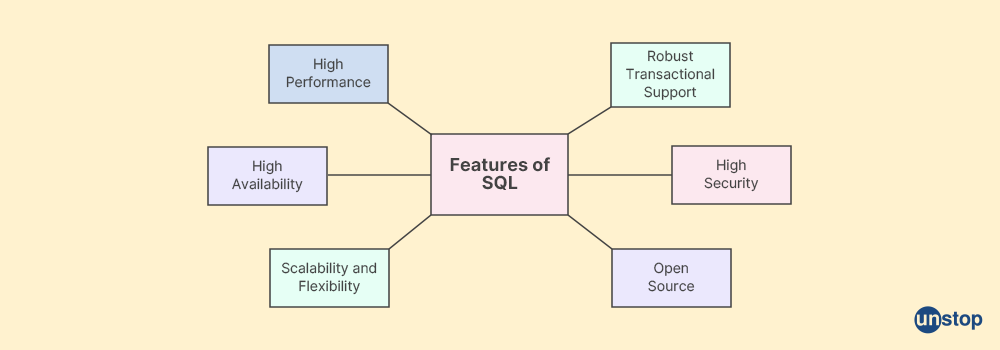
3. What are the advantages of MySQL?
MySQL has several advantages, namely:
1. Scalability: MySQL can grow quickly and efficiently as your data storage needs grow or change. This increases the system's cost and performance efficiency because of its scalability.
2. Open Source availability: Because it is open-source software, you are free to use the systems without any charges. This means there are no hidden costs associated with licensing fees, etc., which allows better budgeting for projects.
3. High performance: One of the key advantages offered by MySQL as compared to other databases is its speed & high-performance levels, even under peak loads.
4. Easy maintenance: Due to its architecture, MySQL makes setup/configuration easy & effortless. This translates to fewer hassles for DB admins/developers while maintaining.
5. Extensive support for web applications: Databases-driven web apps like WordPress, Drupal, and Magento run smoothly on collaborative servers using MySQL.

4. Distinguish the differences between MySQL and SQL.
The differences between MySQL and SQL can primarily be found in their syntaxes (statements used within each language). Compared to MySQL, basic SQL syntax is typically more declarative, allowing users to define exactly what they want without having to give specific instructions on how to get it. Additionally, MySQL supports many features not available in SQL, such as Stored Procedures, Triggers, etc.
5. What is a virtual table in MySQL?
A virtual table in MySQL is an internal data structure used to represent information that can be derived from one or more other tables. However, a virtual table doesn't exist physically as an object on disk.
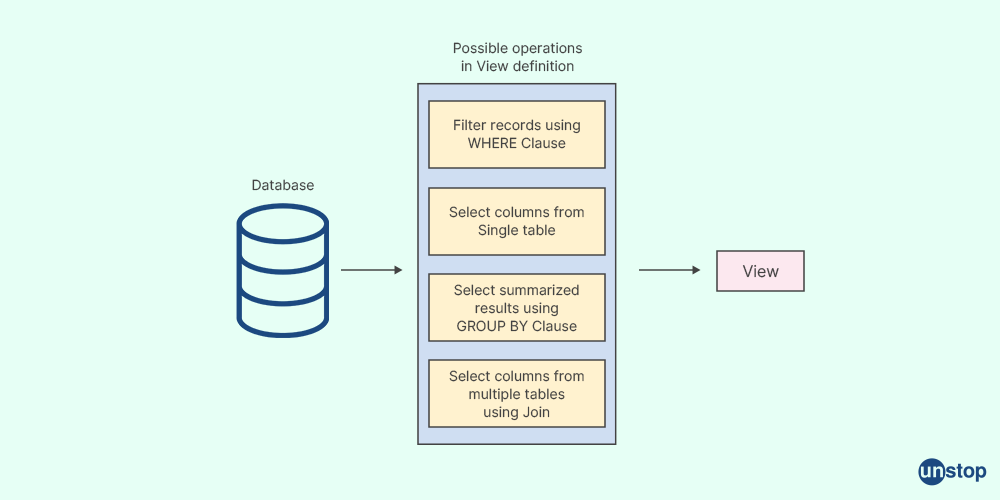
6. What is a source relational table in MySQL?
A source relational table in MySQL is an existing physical database object that contains the data used to populate or update a virtual or target database table.
7. What is a left table in MySQL?
MySQL does not have an independent concept of a "left table". Rather, the concept of "left table" in MySQL exists within the context of a join operation.
The join operation in MySQL has a left table and a right table. As the name suggests, the left table refers to the table that appears on the left side of the join clause. And the right table is the table that appears on the right side.
In MySQL, a left (or outer) join returns all rows from the left-hand side of the "join" statement, even if there are no matches on the right side of the statement; this ensures more complete and accurate results from queries involving multiple tables than traditional inner joins do alone.
8. Explain the different types of tables in MySQL.
In MySQL, there are five different table types, namely:
1. MyISAM Table – This is the default table type and offers high performance with minimal overhead for disk storage. It supports full-text search capabilities and dynamic data structure modifications like adding/deleting columns without rebuilding the entire table.
2. InnoDB Table - This ACID-compliant transaction-safe engine provides a higher reliability level than MyISAM by implementing row-level locking and multi-version concurrency control (MVCC).
3. Memory Table - Also known as a heap or hash table, the memory table stores all records within RAM, which allows them to be retrieved much faster than if they were stored on hard drive disks. However, it requires a more powerful server configuration due to its resource-intensive nature during processing times when compared to other table types offered by MySQL such as MyISAM or InnoDB Tables.
4. Archive Table - As expected, these are read-only tables explicitly designed for archiving large amounts of historical information, not requiring frequent access or updates apart from occasional backups. They efficiently compress all field data, making them ideal solutions where heavy "read" access to the stored information is not needed or desired.
5. Merge Table - A merge table is also known as MRG_MyISAM. It merges 2 MyISAM tables with identical structures and produces a unified view of the merged tables. It's very useful when trying to join and execute queries on very large datasets that would otherwise fail due to limitations associated with JOINS in MySQL. An example of this limitation is the InnoDB Tables which, by default, can only contain up to 32 indexes per table.
Apart from these, MySQL also has a temporary table. As the name suggests, this type of table is created and used for a specific operation and only exists for the duration of the operation. Once the operation is completed, the temporary table is automatically dropped.
9. How do heap tables work in MySQL?
Heap tables are a type of MySQL table that stores information in memory instead of on hard drive storage. The data stored is unordered, and indexes cannot be used to optimize queries against the data. This makes heap tables suitable only for small datasets with infrequent updates. Heap tables also require more intensive operations to maintain accuracy due to a lack of support for transactions or locking mechanisms.
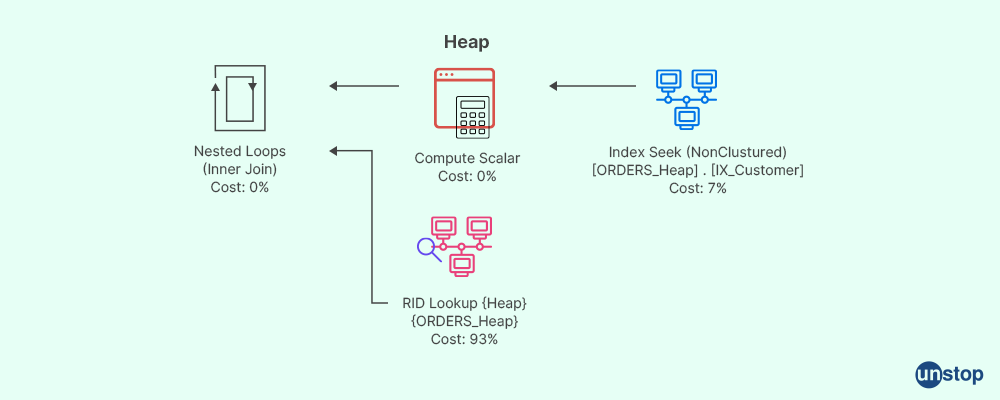
10. What is a Federated table in MySQL?
A Federated table in MySQL is a remote link between two separate databases so that each can access data from the other database without having direct connection details such as IP address, username & password, etc.
11. What information does the table definition contain in MySQL?
Table definitions describe the structure of your database tables. This includes descriptions of the fields (columns) in the tables, along with the data types being used by those columns. It also provides information about any associated constraints like primary/foreign keys declared within the columns. It can also include default values assigned upon row insertion as well as versioning information regarding who created which table and at what time. The versioning information allows tracing the table's history if required, during further analysis.
12. What is the use of Default Storage Engine in MySQL?
The default storage engine for MySQL is InnoDB. It's known to be highly reliable in terms of record safety and security as it supports transactions and locking mechanisms effectively.
13. How do you define a key field within a database table using MySQL?
Key fields are the columns with special behavior used to provide a unique identifier for each row within that table. They can be set by using the primary key or unique constraints in MySQL.
14. When do you set the root password for logging into and operating your MySQL database server instance?
The root password for logging into and operating on your MySql database server instance is usually set during installation time. However, if needed, the root password can be changed later using SQL commands.
15. What default port number should be used to connect with your MySQL server instance?
The default port number to connect with your MySQL server instance is usually 3306, unless a different custom port has been assigned manually at installation time.
16. How can we execute SELECT statements on a database using MySQL?
SELECT statements are used to query data from a database table, either by typing them in an SQL console window or embedding them within software programming code. The software programming code uses it via APIs & Libraries' interface offered by most RDBMSs today.
17. How to store string values in a table of MySQL?
String values can be stored in tables of MySQL through appropriate datatypes like varchar and text, depending on our requirements.
18. What are the steps involved in creating base tables with MySQL?
To create new base tables with MySQL, we need at least two things present: an existing database connection where we should point this query and, secondly, a valid DDL statement as follows:
CREATE TABLE tablename (Field1Name DataType(LengthOfValue), Field2Name DataType(LengthOfValue),....)
19. How can you check if any tables exist before dropping them in MySQL?
Before dropping any tables, it is better to check if they exist already through table checking, by using the following statement:
SHOW TABLES LIKE 'table name';
20. How can we create an empty table statement using MySQL for future inserts of data into the new table created by our query?
We can create an empty table statement in MySQL by using the following query -
CREATE TABLE table name ( ...columns definition like datatypes, length of value etc... ) WITHOUT ROWS;
21. What is the default database engine for MySQL?
The default database engine in MySQL is InnoDB, which provides support for transactions and is ACID-compliant. In recent versions of MySQL, a number of other storage engines are also available such as MyISAM, Falcon, and Memory.
22. How can I grant permissions to a single database in MySQL?
To grant permissions on a specific database or multiple databases within your server, you must use SQL GRANT command syntax like below:
GRANT [permission_type] ON [database_name].* TO '[username]' @' [hostname]'; where permission type consists of CREATE (create new tables), SELECT (retrieve data from existing tables), INSERT (add rows into existing table), UPDATE (modify existing content), DELETE (remove rows).
This will allow users specified with username access rights over the particular data mentioned above, depending on the privileges granted.
23. Can you provide an example or sample password that adheres to best practices when securing a MySQL server?
A good practice for creating passwords is using at least ten characters, including letters, symbols, and numbers. A sample password can be - Ex@mPle#1paSSword2.
24. What is the default port for connecting to a remote MySQL instance?
The standard default port that MySQL server applications use while connecting remotely is 3306. However, this may vary based on system configuration settings, installation options, etc. It's important to always check and listen to ports and configure client tools before establishing connections over different network boundaries.
25. Which comparison operators are commonly used with SQL statements to narrow down results from queries executed against databases?
Some common comparison operators and logical expressions supported and utilized within SQL queries include comparative operators such as Greater than (>), Less than (<), Equal To (=), Not Equal to (!=), etc. Logical expressions like AND, OR and NOT are also used commonly.
26. Explain about joins in MySQL?
A join clause combines records from multiple tables in a database; it enables cross-referencing and retrieving information with fewer individual queries. It is an effective way of combining data retrieved from more than one table into a single record set, based on common columns across both the related tables, usually referred to as "keys".
27. What is the difference between a DBMS schema and a Database Schema?
A DBMS (database management system) schema defines the overall structure of how data is organized and stored. In contrast, database schemas refer to the logical layout of a particular set of components inside a particular DBMS.
28. How does one work in batch mode for making changes to MySQL tables?
To process a batch operation on the table within a database, users first need to create a script containing multiple SQL commands intended to be executed. When using the command line interface mysql client tool utilizes the -e option passing the filename as a parameter. For example:
Mysql –h [hostname] –u[username]-p[password]–D dbnamel-e "script_filename .sql."
29. What is the syntax for creating a single character field in MySQL?
The following syntax can be used when creating fields of type "CHAR" (a fixed length string) or VARCHAR (a variable length string):
CREATE TABLE SampleTable(FieldName CHAR(1)); VARCHAR(1);
This will create a field named "FieldName" in a table called "SampleTable" with either one character for the CHAR type or up to 1 character for VARCHAR.
30. Explain the list of permissions for a user in MySQL.
Permissions in MySQL control what users can do within a database, such as allowing them to query, update, or delete tables. A list of permissions can be defined for each user to have the appropriate access rights to parts of your database.
31. How can I execute batch scripts with MySQL?
Batch scripts can be executed with MySQL using the "MySQL" command line program available from its official download page. The script is written inside a text file and then passed as an argument when running this program like MySQL -u username < myscriptfile.sql.
32. How do you import CSV files?
To import CSV (comma-separated values) files into MySQL, you need to use either the LOAD DATA INFILE syntax or read directly from CSV files through programs that directly support reading/writing these types of files (e..g Python). The general syntax required for importing CSV would look something like this:
LOAD DATA INFILE' filename' INTO TABLE table name FIELDS TERMINATED BY ',';

33. Can you run commands from the command prompt using MySQL?
Yes, it is possible to run commands from the command prompt using MySQL, though some additional configuration may be needed (for example: initially, setting up environment variables, etc.). Once MySQL is configured correctly, simply typing 'mysql' followed by optional arguments will open up a new command shell window for running queries or operations.
34. What type of server host is needed to run an instance of MySQL AB or its derivatives?
Any server that supports the MySQL protocol and has been properly configured should be sufficient to host an instance of MySQL AB or its derivatives, such as MariaDB, Percona Server, etc. Generally, UNIX/Linux servers are preferred, but Windows-based operating systems can be used too, depending on what specific features you require from your database setup.
35. Is a SQL parser available for parsing single statements in MySQL AB?
Yes, a SQL parser is available for parsing single statements in MySQL AB. It allows users to create syntactically correct queries without having any prior knowledge of the syntax rules involved when writing them out manually. This feature comes built into all versions of MySQL, so it doesn't need any additional installation before use – just type in 'mysqlparse' at the prompt and follow instructions as they appear on screen!
36. How do you delete a column from a table using MySQL?
To delete a column from a table using MySQL, execute the following SQL statement:
DELETE FROM [table_name] WHERE [column_name] = "[value to find];"
For example, let's say we want to delete the "age" column and its values from our "users" table. The following query can be used to do so:
DELETE FROM users WHERE age = '30';
If there are multiple rows with the value '30' in this column, all of them will be deleted.
37. What questions should one expect during a job interview for the position of SQL Developer?
Job interviews for an SQL Developer typically involve questions related to database design & architecture, writing complex queries and stored procedures, and data analysis techniques, including normalization forms. Other topics could include knowledge about different Database Management Systems (DBMS), optimization techniques, or model organization strategies that various companies have adopted.
38. How can we use root user privileges to manage our databases in MySQL?
Root user privileges can be used to manage database activities such as creating, deleting, or modifying databases and tables, managing users, granting them access permissions, etc.
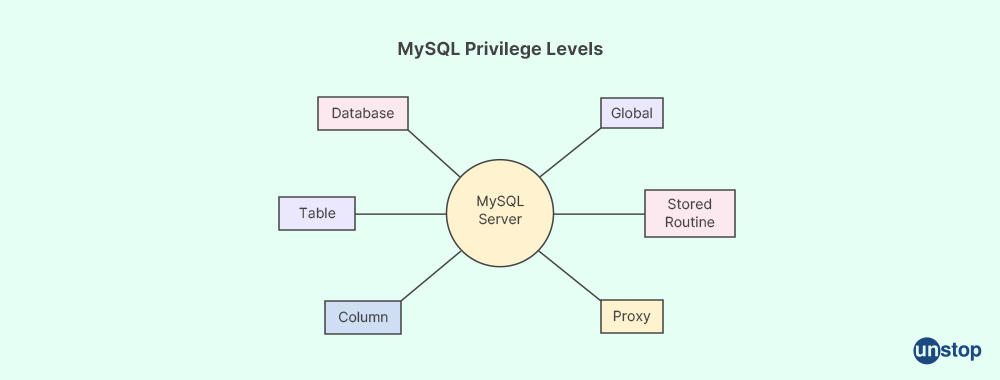
39. Can administrative tools control MySQL server access to tables, columns, or other database objects?
Yes, administrative tools like MySQL Workbench can be used for implementing an Access Control List (ACL) on a MySQL server. This provides more granular control over different parts of a database by allowing the user to specify what kind of operations is permissible when working with certain objects in the database.
40. What is table length, and how does it affect high-speed storage requirements when dealing with large datasets stored within MySQL databases?
Table length refers to the number of columns present in a table and how it impacts high-speed storage requirements when dealing with large datasets stored within MySQL Databases. For example, if we have many rows, then shorter widths for each column will help reduce response times considerably, since less memory needs to be fetched & read during queries compared to larger ones.
41. How can you count characters within character strings using MySQL queries?
To count characters within character strings using MySQL queries, use the "CHAR_LENGTH()" function. This function returns the length of a specified string. For example, consider this query:
SELECT CHAR_LENGTH('This is an example');
The above query will return 17 as the result since there are 17 characters in this string's sentence (including whitespaces).
42. What does Access Control List (ACL) mean on the MySQL server?
An Access Control List or ACL securely grants access rights and privileges for multiple users on the MySQL server. Each user can be given different types of permission, like Read/Write/Create, etc. through ACL. This helps secure databases from unauthorized access and malicious activities.
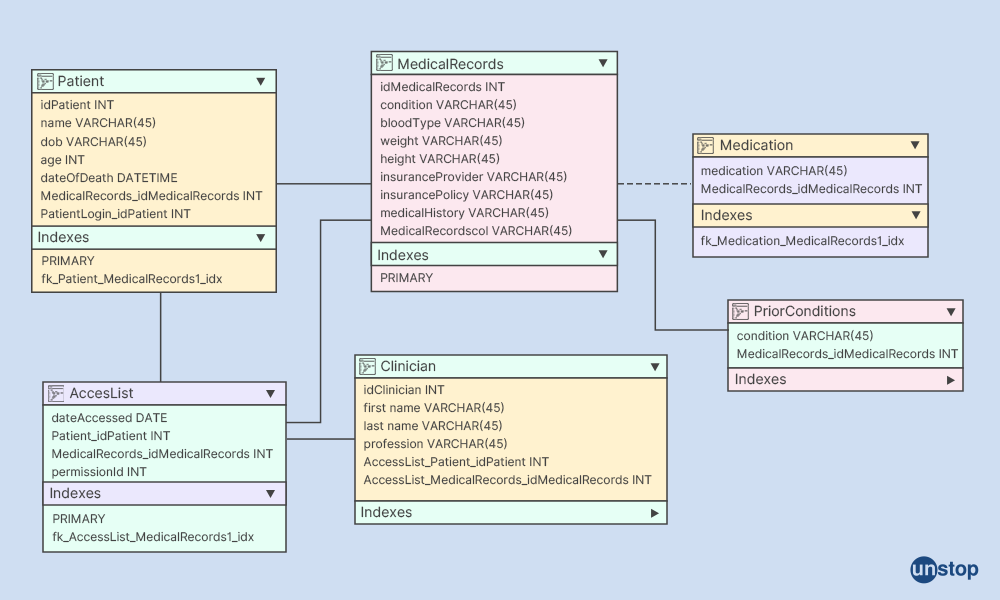
43. What are the different BLOB types?
There are four types of BLOB.
TINYBLOB: A binary large object (BLOB) that can hold up to 255 bytes.
BLOB: A BLOB designed for storing a range of unstructured data such as images, text, audio or video files of any size. It has a maximum length of 65,535 bytes and is often used to store large data in databases.
MEDIUMBLOB: Similar to BLOBS but with a slightly larger capacity - 16MB max length - making it suitable for longer documents like videos and music recordings.
LONGBLOB: The largest type provides an even greater amount of storage space than the MEDIUMBLOB, up to 4 gigabytes per object. It is used for longer audio and video files and large amounts of text.
44. List the different types of relationships available in MySQL.
MySQL supports the following relationship types between two tables:
- One-to-One: a single row from one table links to only one row in the related table.
- One-to-Many: records exist in two tables and each record on one side can relate to multiple records on the other.
- Many-to-Many: there are numbers or rows on both sides which link with each other depending upon matching primary/foreign key values.
- Many-To-One Relationships: This type involves connecting several instances from multiple tables into a single entry in a separate table.
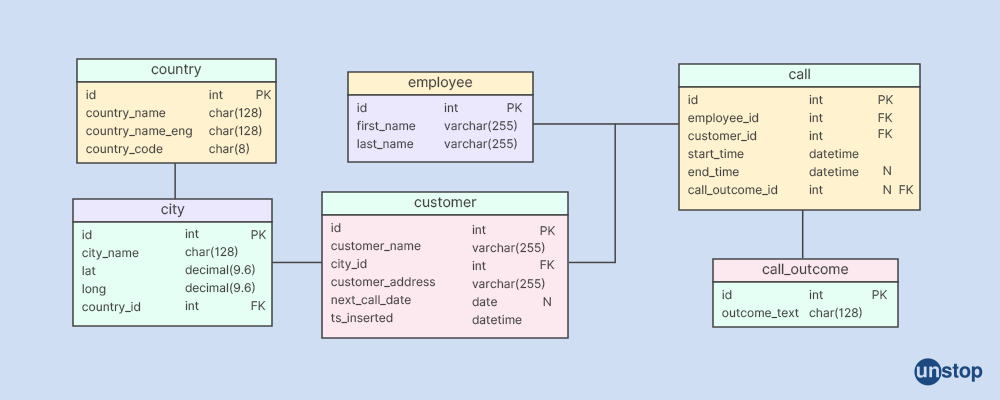
45. How do ACID properties help ensure data integrity and consistency in Databases like MySQL?
The acronym ACID stands for Atomicity, Consistency, Isolation, and Durability. This describes the characteristics of database transactions that guarantee reliability even when errors or issues occur during operations.
- The atomicity property ensures all parts of a transaction are completed, or none at all, guaranteeing logical units are maintained within databases when executing multiple instructions related to a single set of work.
- The consistency property ensures that only valid data can be entered into the database. Any changes in one transaction cannot affect any other transactions, and existing rules must apply to all subsequent transactions.
- Isolation pertains to how visible different operations are from each other when executed concurrently (similarly at the same time).
- Lastly, durability states that every committed action is stored permanently, even if there’s an unexpected shutdown or power failure.
46. What are the different types of joins in MySQL? Explain them.
There are multiple types of join operators available for use within MySQL. These are:
- INNER JOIN - Used to connect two or more tables when matching rows find related columns.
- LEFT OUTER JOIN - Used to retrieve all values stored inside the left side of the associated statement, ignoring if entries exist in counterparts.
- RIGHT OUTER JOIN - similar to the left outer join, this retrieves the entire contents located in the right side of the target table, regardless of the lack of counterparts.
- FULL OUTER JOIN - This combines result set obtained through a successive union on both sides. It returns complete sets from each side.
- Cross Join - A cross join is a special type of Cartesian product where the join clause to specify the relationship between columns and rows in two or more tables is omitted. This produces all possible combinations of rows from both participating tables, allowing us to discover and analyze data trends across multiple dimensions.
- Self Join - A self-join occurs when an SQL statement uses a table name in its FROM clause twice so that it can be related to itself. It creates joins by using column values as criteria for joining records together within one table structure, allowing you to compare results against themselves within the same dataset.
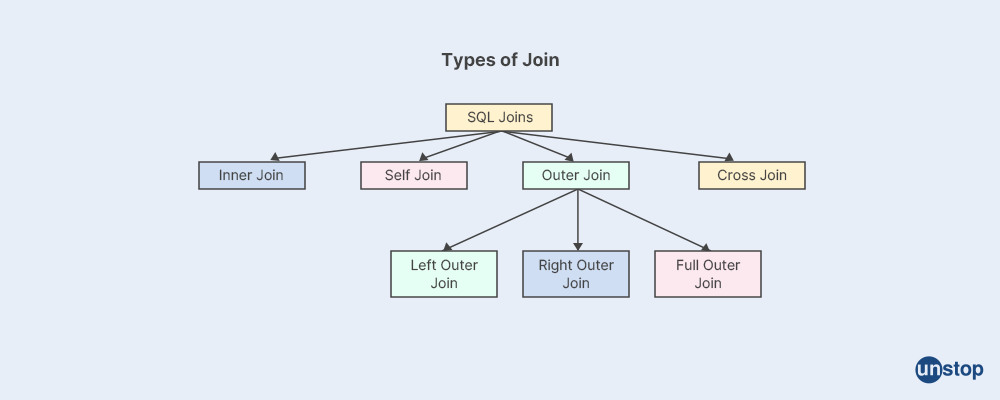
47. What is the difference between MySQL's string objects and binary objects?
MySQL strings are a type of object that allows the storage and manipulation of text-based data, such as character sequences. These strings can be encoded in either Unicode or non-Unicode format, with the ability to store single bytes (non-Unicode) and multiple byte characters (Unicode) depending on the encoding specified.
Binary objects, however, allow for efficient storage and transmission of binary data across networks through compression techniques without needing any conversion into an alternate format first.
Additionally, they are not limited by typical string length restrictions found when dealing with textual information. So, large chunks of binary code or smaller segments can be easily stored within this object type without significant overhead costs.
48. What are grant tables and static tables in terms of MySQL?
Grant tables are system tables in MySQL that store information about user privileges and access control. They specify which operations users can perform on the database, like creating or dropping databases and tables, running queries, etc.
Static tables are not a commonly used concept in MySQL. But, in the general context of databases, static tables refer to data that remains constant over time.
Start prepping for your MySQL interview with these interview questions!
You may also be interested in the following:
As a biotechnologist-turned-writer, I love turning complex ideas into meaningful stories that inform and inspire. Outside of writing, I enjoy cooking, reading, and travelling, each giving me fresh perspectives and inspiration for my work.
Login to continue reading
And access exclusive content, personalized recommendations, and career-boosting opportunities.
Subscribe
to our newsletter
Blogs you need to hog!

This Is My First Hackathon, How Should I Prepare? (Tips & Hackathon Questions Inside)

10 Best C++ IDEs That Developers Mention The Most!

Advantages and Disadvantages of Cloud Computing That You Should Know!













Comments
Add comment